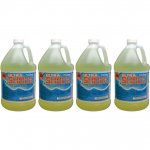I have been using the BBB method for several years now and always seam to have high PH. Everyone in this form says liquid chlorine doesn't drive up PH but i seams too in my pool.
I have a 25,000 gallon plaster swimming pool and i use a Stenner 3GPD pump with a 7.5 gallon tank.
I inject my liquid chlorine at night at a rate of about 3/4 gallon per day. I usually check my PH when i get home from work which is about 12 hours after the chlorine was dispensed and always have high PH... dark red on the test kit cant even tell a number... off the chart!.
I try and maintain around 1PPM and 0-.5 PPM used chlorine. It is typically in that range when i get home form work around 5:30 pm.
So i dump some acid in and it comes down as expected, only to start the cycle all over again. So decided to try the co2 thing, i used a 5lb tank from a beer tap and injected into the return water. My method was lets say less than scientific. and not sure how much CO2 went in. I basically let in on for a few burst of 10-15 seconds each.
and not sure how much CO2 went in. I basically let in on for a few burst of 10-15 seconds each.
The co2 brought down ph as expected but it seams to keep it down longer (next day was still good)
So this brings me to several questions...
why is my PH always high?
Does acid not work as well as co2 for longevity?
Is there a economical co2 injection system for residential pools?
Should i use an acid injection system.
Which is better co2 or acid?
How do you determine how much co2 to dispence to bring down PH to desired level?
Water chemistry is...
FC 1.0
PH7.4
Alk 110
Calcium Hardness 260
CYA 40
This is the chlorine i have been using
I have a 25,000 gallon plaster swimming pool and i use a Stenner 3GPD pump with a 7.5 gallon tank.
I inject my liquid chlorine at night at a rate of about 3/4 gallon per day. I usually check my PH when i get home from work which is about 12 hours after the chlorine was dispensed and always have high PH... dark red on the test kit cant even tell a number... off the chart!.
I try and maintain around 1PPM and 0-.5 PPM used chlorine. It is typically in that range when i get home form work around 5:30 pm.
So i dump some acid in and it comes down as expected, only to start the cycle all over again. So decided to try the co2 thing, i used a 5lb tank from a beer tap and injected into the return water. My method was lets say less than scientific.
The co2 brought down ph as expected but it seams to keep it down longer (next day was still good)
So this brings me to several questions...
why is my PH always high?
Does acid not work as well as co2 for longevity?
Is there a economical co2 injection system for residential pools?
Should i use an acid injection system.
Which is better co2 or acid?
How do you determine how much co2 to dispence to bring down PH to desired level?
Water chemistry is...
FC 1.0
PH7.4
Alk 110
Calcium Hardness 260
CYA 40
This is the chlorine i have been using


